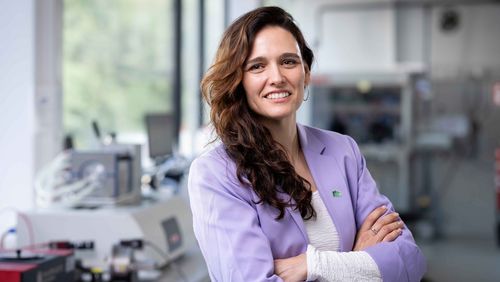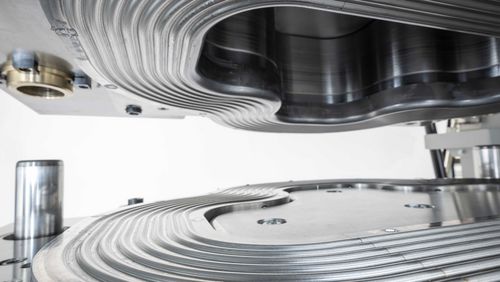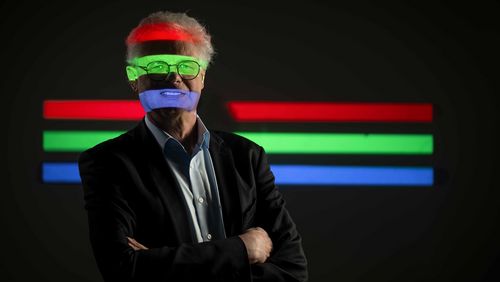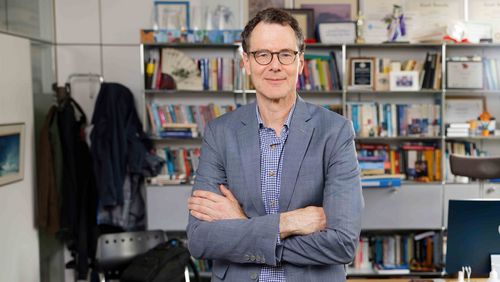
A geothermal power plant in every town
Major achievement for geophysicist Martin O. Saar: the Werner Siemens Foundation Endowed Chair of Geothermal Energy and Geofluids at ETH Zurich has been named lead scientist in a top-tier Innosuisse project. If he and his team succeed in preparing their innovative PPGD deep drilling technology for market entry, it’s possible that hundreds of geothermal power plants will supply Switzerland with clean energy from the earth’s interior.
Geothermal energy plays a minor role in Switzerland’s 2050 energy strategy, with current models predicting it will make up just four percent of all energy produced. However, Martin O. Saar, the Werner Siemens Foundation Endowed Chair of Geothermal Energy and Geofluids at ETH Zurich, argues that these models take an all-too pessimistic view of geothermal power. Indeed, he’s convinced that if we take modern technologies into account – Advanced Geothermal Systems (AGS), for instance – the potential of geothermal energy is significantly higher.
In the new project, Professor Martin O. Saar is aiming to calculate this potential while also taking a major step towards exploiting it. Recently, he and his R&D colleagues from academia and industry were awarded an Innosuisse Flagship Grant (AEGIS-CH) worth 11.4 million Swiss francs. Approximately two-thirds of this amount is supplied by industry partners SwissGeoPower AG, Geotherm Ltd/Kibag Bauleistungen AG, Basler & Hofmann Ltd, Amberg Group Ltd and Sika Switzerland Ltd. One-third of the funds stems from the Swiss Innovation Agency Innosuisse and is disbursed to the participating partner institutions ETH Zurich, the Paul Scherrer Institute and the Eastern Switzerland University of Applied Sciences. The large-scale project is scheduled to last four years.
High voltage down deep
A large part of the research will focus on the drilling technology “Plasma Pulse Geo Drilling” (PPGD), in which the firm Kammermann Prozesstechnik GmbH also has a major role. The goal is to one day use PPGD technology to harness the earth’s energy at depths of roughly eight kilometres and either convert it cost-effectively into electricity or use it directly as heat. Today’s drilling technologies are horrendously expensive, says Saar. “Using them to extract heat at these kinds of depths is financially uninteresting.”
Unlike current methods that apply mechanical pressure from above to fracture rocks, PPGD operates as a type of electric shock: within a mere 500 nanoseconds, a generator produces electric potential of up to 600,000 volts between the electrodes fitted on the drill bit, creating a plasma – a lightning bolt, so to speak – to fracture the rock from the inside via tensile strain. This approach requires only about a quarter of the energy consumed in standard drilling procedures. Moreover, it causes no wear and tear on the drill bit – specifically on the electrodes – making it unnecessary to change the bit during a drilling session.
Oversize generator a major obstacle
Saar and the AEGIS-CH team plan to use this method to develop power plants that function much like the downhole heat exchangers found frequently in residential buildings. Their idea is to drill two boreholes down to a depth of roughly eight kilometres and then join them to create a U-shaped loop. Inside this loop, a circulation fluid absorbs the underground heat and transports it to the surface, where it can be used as district heating or channelled to a turbine to generate electricity. “But rather than using water as the circulation fluid, we plan to use CO2,” Saar explains. “The carbon dioxide isn’t released into the atmosphere – and it also has several advantages over water, including its lower viscosity, which increases the rate of underground heat production.”
Before the method is put into practice, however, several challenges await, among them drilling the U-shaped loop. “We have to be able to drill a curve at a great depth,” Saar says. However, the literally greatest obstacle is the pulse generator used to produce the enormous voltage between the electrodes when drilling into the rock layers: “Right now, it’s the size of a shipping container”.
For the drilling method to function, the pulse generator must be small enough to fit in the borehole, with a maximum diameter of about fifty centimetres. Saar explains that it’s essential for the electric pulses to be generated directly behind the drill bit, as this is the only way to ensure that all electric jolts are discharged within 500 nanoseconds. If the pulses first had to travel several kilometres down the entire borehole, the surge in pulses would take too long, and no “lightning bolt” – hence no plasma – would be generated in the rock layers.
A geothermal power plant in every town
Saar is optimistic about miniaturising the pulse generator and confident that this step will pave the way to building economically viable geothermal power plants based on Advanced Geothermal Systems (AGS). Saar estimates that a plant capable of extracting the earth’s heat from depths of roughly eight kilometres would deliver heating or electricity for 500 to 1000 people. He also points out that the system could be used virtually anywhere, as the new drilling technology would work even in deep – and thus hard – rock layers.
This capacity is at the heart of the AEGIS-CH concept to create a Swiss-wide grid of hundreds of small power plants. Every commune could build its own geothermal power plant to produce heat or electricity, Saar says. And the benefits of a decentralised grid aren’t limited to the short distribution distances. It also offers energy security – a reliance on large power plants is dangerous, as Russia’s invasion of Ukraine has demonstrated.
Avoiding energy shortages
Another advantage is that AGS geothermal power plants would be functional year-round, delivering sustainable energy with absolutely no CO2 emissions during operations. This consistency is particularly important in avoiding energy shortages, Saar stresses, as these plants could fill the gap in the event that darkness and wind lulls occur at the same time, preventing renewable energy sources like solar or wind from generating power.
In addition to the AEGIS-CH project, Saar’s research group also has other irons in the fire, including numerous projects in geothermal energy and geofluids that all share a common aim: making our energy supply more sustainable while curbing global warming.
The outlook is promising, and if the project is successful one thing is certain: with its decision to award a ten-year grant to the ETH Zurich professorship for geothermal energy and geofluids, the Werner Siemens Foundation will have effectively laid the cornerstone for raising geothermal power from a minor player to a leading light in the global supply of energy.



